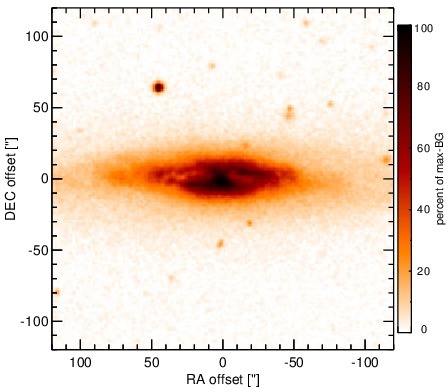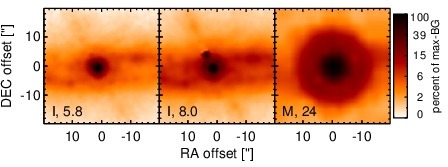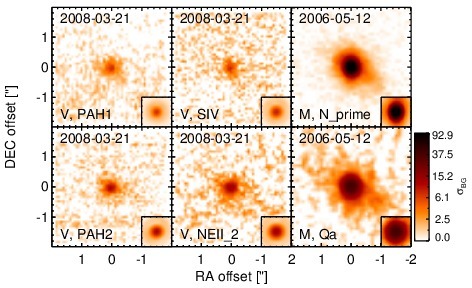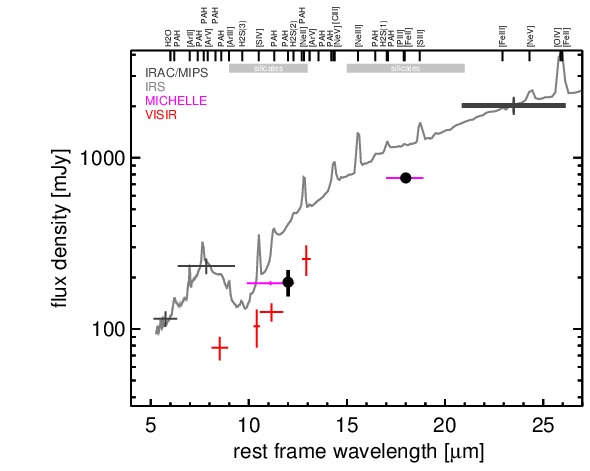Sasmirala Individual Information for NGC 4388
Description
NGC 4388 is an almost edge-on spiral galaxy in the Virgo cluster [phillips_ngc_1982] at a distance of D = 19.2 ± 6.6 Mpc (NED redshift-independent median) with a Sy 2 nucleus [trippe_multi-wavelength_2010] with broad emission lines in polarized light [shields_reality_1996]. The AGN is one of the X-ray brightest objects of its class in terms of flux. It is an X-ray “buried” AGN candidate [noguchi_new_2009] and belongs to the nine-month BAT AGN sample. NGC 4388 possesses a very extended NLR over several kiloparsecs towards the north-east and somewhat to the south-west (PA~ 30∘; e.g.,[colina_extended_1987, pogge_extended_1988, veilleux_galactic-scale_1999, yoshida_discovery_2002]), which roughly coincides with the radio morphology (e.g., [stone_collimated_1988, hummel_anomalous_1991, falcke_hst_1998]). It also features nuclear water maser disc [braatz_green_2004]. After first being detected in the MIR with IRAS, NGC 4388 was followed up with ground-based MIR instruments [scoville_10_1983, devereux_infrared_1987, roche_atlas_1991, stone_collimated_1988], and the space-based ISO [boselli_mid-ir_1998, boselli_mid-ir_2003, roussel_atlas_2001, ramos_almeida_mid-infrared_2007]. The first subarcsecond N-band observations were performed with Palomar 5 m/MIRLIN in 2000 [gorjian_10_2004] and ESO 3.6 m/TIMMI2 in 2002 [siebenmorgen_mid-infrared_2004]. In both cases, an unresolved nucleus without any host emission was detected. The host becomes visible as extended spiral-like emission in the Spitzer/IRAC and MIPS images, while a compact nucleus still dominates. Our measured nuclear IRAC 5.8 and 8.0 μm fluxes are significantly lower than the values reported in [gallimore_infrared_2010] but agree with the Spitzer/IRS LR staring mode spectrum. The latter exhibits a deep silicate 10 μm absorption feature, PAH emission and a steep red spectral slope in νFν-space (see also [shi_9.7_2006, wu_spitzer/irs_2009, deo_mid-infrared_2009, tommasin_spitzer-irs_2010, gallimore_infrared_2010]). The nuclear region of NGC 4388 was observed with Michelle in the N’ and Qa filters in 2006 [ramos_almeida_infrared_2009], and with VISIR in four narrow N-band filters in 2008 (partly published in [gandhi_resolving_2009]). A marginally resolved nucleus was detected in all images but with uncertain morphology. In particular, a number of VISIR images suffer from low S/N < 10. The Michelle images have the highest S/N and show an emission ”finger“ extending ~ 1.1arcsec ~ 100 pc to the south-west, roughly consistent with the ionization cone (PA~-135∘; see also [ramos_almeida_infrared_2009]). We extract only the unresolved nuclear component, which provides fluxes consistent with [ramos_almeida_infrared_2009] and [gandhi_resolving_2009]. The resulting nuclear MIR SED is on average ~ 51% lower than the Spitzer spectrophotometry and indicates a similar silicate absorption depth. This matches the TIMMI2 LR N-band spectrum from [siebenmorgen_mid-infrared_2004], which in addition does not possess any PAH feature emission. Therefore, the arcsecond-scale MIR SED is significantly affected by star formation, which is located either around the nucleus or along our line of sight in the host disc.
- [boselli_mid-ir_1998] A. Boselli, J. Lequeux, M. Sauvage, O. Boulade, F. Boulanger, D. Cesarsky, C. Dupraz, S. Madden, F. Viallefond, and L. Vigroux. Mid-IR emission of galaxies in the virgo cluster. II. integrated properties . A&A , 335 pp. 53–68, July 1998.
- [boselli_mid-ir_2003] A. Boselli, M. Sauvage, J. Lequeux, A. Donati, and G. Gavazzi. Mid-IR emission of galaxies in the virgo cluster III. the data . A&A , 406 pp. 867–877, August 2003.
- [braatz_green_2004] J. A. Braatz, C. Henkel, L. J. Greenhill, J. M. Moran, and A. S. Wilson. A green bank telescope search for water masers in nearby active galactic nuclei . ApJL , 617 pp. L29–L32, December 2004.
- [colina_extended_1987] L. Colina, K. J. Fricke, W. Kollatschny, and M. A. C. Perryman. Extended emission line regions in nearby seyfert galaxies. II - NGC 4388 . A&A , 186 pp. 39–48, November 1987.
- [deo_mid-infrared_2009] Rajesh P. Deo, Gordon T. Richards, D. M. Crenshaw, and S. B. Kraemer. The mid-infrared continua of seyfert galaxies . ApJ , 705 pp. 14–31, November 2009.
- [devereux_infrared_1987] Nicholas A. Devereux, E. E. Becklin, and Nick Scoville. Infrared characteristics of the nuclei of normal galaxies . ApJ , 312 pp. 529–541, January 1987.
- [falcke_hst_1998] Heino Falcke, Andrew S. Wilson, and Chris Simpson. HST and VLA observations of seyfert 2 galaxies: The relationship between radio ejecta and the narrow-line region . ApJ , 502 pp. 199, July 1998.
- [gallimore_infrared_2010] J. F. Gallimore, A. Yzaguirre, J. Jakoboski, M. J. Stevenosky, D. J. Axon, S. A. Baum, C. L. Buchanan, M. Elitzur, M. Elvis, C. P. O'Dea, and A. Robinson. Infrared spectral energy distributions of seyfert galaxies: Spitzer space telescope observations of the 12 μm sample of active galaxies . ApJS , 187 pp. 172–211, March 2010.
- [gandhi_resolving_2009] P. Gandhi, H. Horst, A. Smette, S. Hönig, A. Comastri, R. Gilli, C. Vignali, and W. Duschl. Resolving the mid-infrared cores of local seyferts . A&A , 502 pp. 457–472, August 2009.
- [gorjian_10_2004] V. Gorjian, M. W. Werner, T. H. Jarrett, D. M. Cole, and M. E. Ressler. 10 micron imaging of seyfert galaxies from the 12 micron sample . ApJ , 605 pp. 156–167, April 2004.
- [hummel_anomalous_1991] E. Hummel and D. J. Saikia. The anomalous radio features in NGC 4388 and NGC 4438 . A&A , 249 pp. 43–56, September 1991.
- [noguchi_new_2009] Kazuhisa Noguchi, Yuichi Terashima, and Hisamitsu Awaki. A new sample of buried active galactic nuclei selected from the second XMM-Newton serendipitous source catalogue . ApJ , 705 pp. 454–467, November 2009.
- [phillips_ngc_1982] M. M. Phillips and D. F. Malin. NGC 4388 - a seyfert 2 galaxy in the virgo cluster . MNRAS , 199 pp. 905–913, June 1982.
- [pogge_extended_1988] Richard W. Pogge. A extended ionizing radiation cone from the nucleus of the seyfert 2 galaxy NGC 1068 . ApJ , 328 pp. 519–522, May 1988.
- [ramos_almeida_infrared_2009] C. Ramos Almeida, N. A. Levenson, J. M. Rodríguez Espinosa, A. Alonso-Herrero, A. Asensio Ramos, J. T. Radomski, C. Packham, R. S. Fisher, and C. M. Telesco. The infrared nuclear emission of seyfert galaxies on parsec scales: Testing the clumpy torus models . ApJ , 702 pp. 1127–1149, September 2009.
- [ramos_almeida_mid-infrared_2007] C. Ramos Almeida, A. M. Pérez García, J. A. Acosta-Pulido, and J. M. Rodríguez Espinosa. The mid-infrared emission of seyfert galaxies: A new analysis of ISOCAM data . AJ , 134 pp. 2006–2019, November 2007.
- [roche_atlas_1991] Patrick F. Roche, David K. Aitken, Craig H. Smith, and Martin J. Ward. An atlas of mid-infrared spectra of galaxy nuclei . MNRAS , 248 pp. 606–629, February 1991.
- [roussel_atlas_2001] H. Roussel, L. Vigroux, A. Bosma, M. Sauvage, C. Bonoli, P. Gallais, T. Hawarden, J. Lequeux, S. Madden, and P. Mazzei. An atlas of mid-infrared dust emission in spiral galaxies . A&A , 369 pp. 473–509, April 2001.
- [scoville_10_1983] N. Z. Scoville, E. E. Becklin, J. S. Young, and R. W. Capps. A 10 micron survey of star formation in galactic nuclei virgo spiral galaxies . ApJ , 271 pp. 512–523, August 1983.
- [shi_9.7_2006] Y. Shi, G. H. Rieke, D. C. Hines, V. Gorjian, M. W. Werner, K. Cleary, F. J. Low, P. S. Smith, and J. Bouwman. 9.7 μm silicate features in active galactic nuclei: New insights into unification models . ApJ , 653 pp. 127–136, December 2006.
- [shields_reality_1996] J. C. Shields and A. V. Filippenko. On the reality of extended seyfert 1 emission in NGC 4388. . A&A , 311 pp. 393–396, July 1996.
- [siebenmorgen_mid-infrared_2004] R. Siebenmorgen, E. Krügel, and H. W. W. Spoon. Mid-infrared emission of galactic nuclei. TIMMI2 versus ISO observations and models . A&A , 414 pp. 123–139, January 2004.
- [stone_collimated_1988] John L. Stone, Andrew S. Wilson, and Martin J. Ward. Collimated nuclear ejection of radio-emitting plasma in the seyfert galaxy NGC 4388 . ApJ , 330 pp. 105–110, July 1988.
- [tommasin_spitzer-irs_2010] Silvia Tommasin, Luigi Spinoglio, Matthew A. Malkan, and Giovanni Fazio. Spitzer-IRS high-resolution spectroscopy of the 12 μm seyfert galaxies. II. results for the complete data set . ApJ , 709 pp. 1257–1283, February 2010.
- [trippe_multi-wavelength_2010] M. L. Trippe, D. M. Crenshaw, R. P. Deo, M. Dietrich, S. B. Kraemer, S. E. Rafter, and T. J. Turner. A multi-wavelength study of the nature of type 1.8/1.9 seyfert galaxies . ApJ , 725 pp. 1749–1767, December 2010.
- [veilleux_galactic-scale_1999] Sylvain Veilleux, Jonathan Bland-Hawthorn, Gerald Cecil, R. Brent Tully, and Scott T. Miller. Galactic-scale outflow and supersonic ram-pressure stripping in the virgo cluster galaxy NGC 4388 . ApJ , 520 pp. 111–123, July 1999.
- [wu_spitzer/irs_2009] Yanling Wu, Vassilis Charmandaris, Jiasheng Huang, Luigi Spinoglio, and Silvia Tommasin. Spitzer/IRS 5-35 μm low-resolution spectroscopy of the 12 μm seyfert sample . ApJ , 701 pp. 658–676, August 2009.
- [yoshida_discovery_2002] Michitoshi Yoshida, Masafumi Yagi, Sadanori Okamura, Kentaro Aoki, Youichi Ohyama, Yutaka Komiyama, Naoki Yasuda, Masanori Iye, Nobunari Kashikawa, Mamoru Doi, Hisanori Furusawa, Masaru Hamabe, Masahiko Kimura, Masayuki Miyazaki, Satoshi Miyazaki, Fumiaki Nakata, Masami Ouchi, Maki Sekiguchi, Kazuhiro Shimasaku, and Hiroshi Ohtani. Discovery of a very extended emission-line region around the seyfert 2 galaxy NGC 4388 . ApJ , 567 pp. 118–129, March 2002.
Images

Optical image (DSS, red filter). Displayed are the central 4 arcmin with North being up and East to the left. The colour scaling is linear with white corresponding to the median background (BG) and black to the 0.01% pixels with the highest intensity.

Spitzer MIR images. Displayed are the inner 40 arcsec with North being up and East to the left. The colour scaling is logarithmic with white corresponding to median BG and black to the 0.1% pixels with the highest intensity. The label in the bottom left states instrument and central wavelength of the filter in micron (I: IRAC, M: MIPS).

Subarcsecond-resolution MIR images sorted by increasing filter central wavelength. Displayed are the inner 4 arcsec with North being up and East to the left. The colour scaling is logarithmic with white corresponding to median BG and black to the 75% of the highest intensity of all images in units of sig_bg. The inset image (where present; either bottom or top right) shows the central arcsecond of the PSF from the calibrator star, scaled to match the science target. The labels in the bottom left state instrument and filter names (C: COMICS, M: Michelle, T: T-ReCS, V: VISIR).
SEDs


MIR SED. The description of the symbols in all the SED plots (where present) is the following: Grey crosses and solid lines mark the Spitzer/IRAC, MIPS and IRS data. The colour coding of the other symbols is as follows: green for COMICS, magenta for Michelle, blue for T-ReCS and red for VISIR data. Darker-coloured solid lines mark spectra of the corresponding instrument. The black filled circles mark the nuclear 12 and 18 micron continuum emission estimate from the data (where present). The ticks on the top axis mark positions of common MIR emission lines, while the light grey horizontal bars mark wavelength ranges affected by the silicate 10 and 18 micron features.